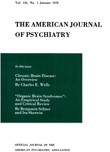CLINICAL AND ELECTROENCEPHALOGRAPHIC STUDIES
Abstract
1. One hundred cases with organic brain disease and delta activity in the electroencephalogram were studied for correlations of the psychiatric status with the electroencephalogram and anatomical localization.
2. This investigation showed that disturbances such as memory defect, mental retardation, dullness, inability to concentrate, overactivity and slight euphoria can occur without any delta activity in the electroencephalogram. They may be present also with a small amount of delta activity. Higher amounts of delta activity are associated with the syndromes of clouded consciousness and facetiousness. The delta activity was more equally distributed over the brain in cases with sleepiness and clouding of consciousness than in cases with facetiousness. The latter showed a relatively high amount of delta activity over both frontal lobes and a smaller amount over other regions (for exact numbers see summary on page 44).
3. Facetiousness is associated with dysfunction, not afunction, of both frontal lobes with a smaller degree of dysfunction of other parts of the hemispheres. The electroencephalographic results in this respect are in good agreement with the fact that facetiousness was most frequently found in lesions restricted to the frontal lobes and not invading other parts of the hemispheres. For further correlations between anatomical findings and psychiatric symptoms see page 45.
4. The degree of correlation between the electroencephalogram and the psychiatric symptoms was higher than the degree of correlation between the anatomy of the lesion and the psychiatric symptoms. Electroencephalography promises to be of further assistance in the correlation between disturbances of cerebral mechanisms and behavior, particularly in the differentiation between such psychic disturbances as are associated with a pure loss of cerebral tissue and such psychic disturbances as are associated with dysfunction of the remaining cerebral tissue.
Access content
To read the fulltext, please use one of the options below to sign in or purchase access.- Personal login
- Institutional Login
- Sign in via OpenAthens
- Register for access
-
Please login/register if you wish to pair your device and check access availability.
Not a subscriber?
PsychiatryOnline subscription options offer access to the DSM-5 library, books, journals, CME, and patient resources. This all-in-one virtual library provides psychiatrists and mental health professionals with key resources for diagnosis, treatment, research, and professional development.
Need more help? PsychiatryOnline Customer Service may be reached by emailing [email protected] or by calling 800-368-5777 (in the U.S.) or 703-907-7322 (outside the U.S.).



